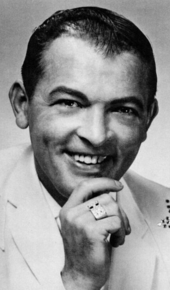
In 1957, Billboard magazine published three charts covering the best-performing country music songs in the United States: Most Played C&W in Juke Boxes, which had appeared in Billboard since 1944, C&W Best Sellers in Stores, which had debuted in 1948, and Most Played C&W by Jockeys, which had launched in 1949. The "C&W" used in the titles of the charts was an abbreviation for "country and western", a term which Billboard had adopted for the genre in 1949, replacing the earlier "folk music". [1] The Juke Box chart was published for the final time in the issue of Billboard dated June 17, 1957. The other two listings merged in 1958 to form a combined chart, which since 2005 has been published as Hot Country Songs. [2]
Contents
At the start of 1957, the number-one position on all three charts was held by "Singing the Blues" by Marty Robbins, who achieved a second number one in June with "A White Sport Coat (And A Pink Carnation)". The latter song also topped all three charts and was at number one on the final C&W juke box chart published by Billboard. Robbins was the only artist with more than one chart-topper on the juke box listing, and his total of eleven weeks in the top spot was the most by any artist on the chart. Three other acts had more than one country number one in 1957. Bobby Helms took both "Fraulein" and "My Special Angel" to the top of both the best sellers and jockeys charts; the singles were his first two chart entries but would prove to be the only country number ones of his career. [3] The Everly Brothers also topped both charts with "Bye Bye Love" and "Wake Up Little Susie". Elvis Presley was the only act with three country number ones during the year; he reached the peak position on the juke box chart in May with "All Shook Up" and later in the year topped the best sellers chart with the double-sided entries "Teddy Bear" / "Loving You" and "Jailhouse Rock" / "Treat Me Nice". Despite their success on the other charts, none of Presley's songs topped the jockeys chart, which was based on radio airplay. Three songs topped only the jockeys chart, including "Four Walls" by Jim Reeves, which spent eight non-consecutive weeks atop the listing beginning in May, but failed to top either of the other two charts.
Sonny James achieved his first country number one in 1957 with "Young Love", which also topped Billboard's pop airplay chart. [4] The singer, dubbed the "Southern Gentleman", would go on to become one of the most successful artists in country music history, with more than 20 number ones. [5] [6] Rock and roll pioneer Jerry Lee Lewis, whose early recordings were successful on the country charts, reached number one for the first time in September with "Whole Lotta Shakin' Goin' On", [7] which was also a rhythm and blues number one. [8] The song has been included on lists of the greatest tracks of all time, [9] and in 2015 was selected for permanent preservation in the National Recording Registry at the Library of Congress. [10] The Everly Brothers also topped the country charts for the first time, with "Bye Bye Love", [11] and returned to number one later in the year with "Wake Up Little Susie", which also topped Billboard's pop and R&B charts. [12] The brothers had the highest total number of weeks atop both the country best sellers and jockeys charts, with 14 and 15 weeks respectively at number one. "Gone" by Ferlin Husky had the longest unbroken run at number one on any of the charts, topping the best sellers chart for ten consecutive weeks.




